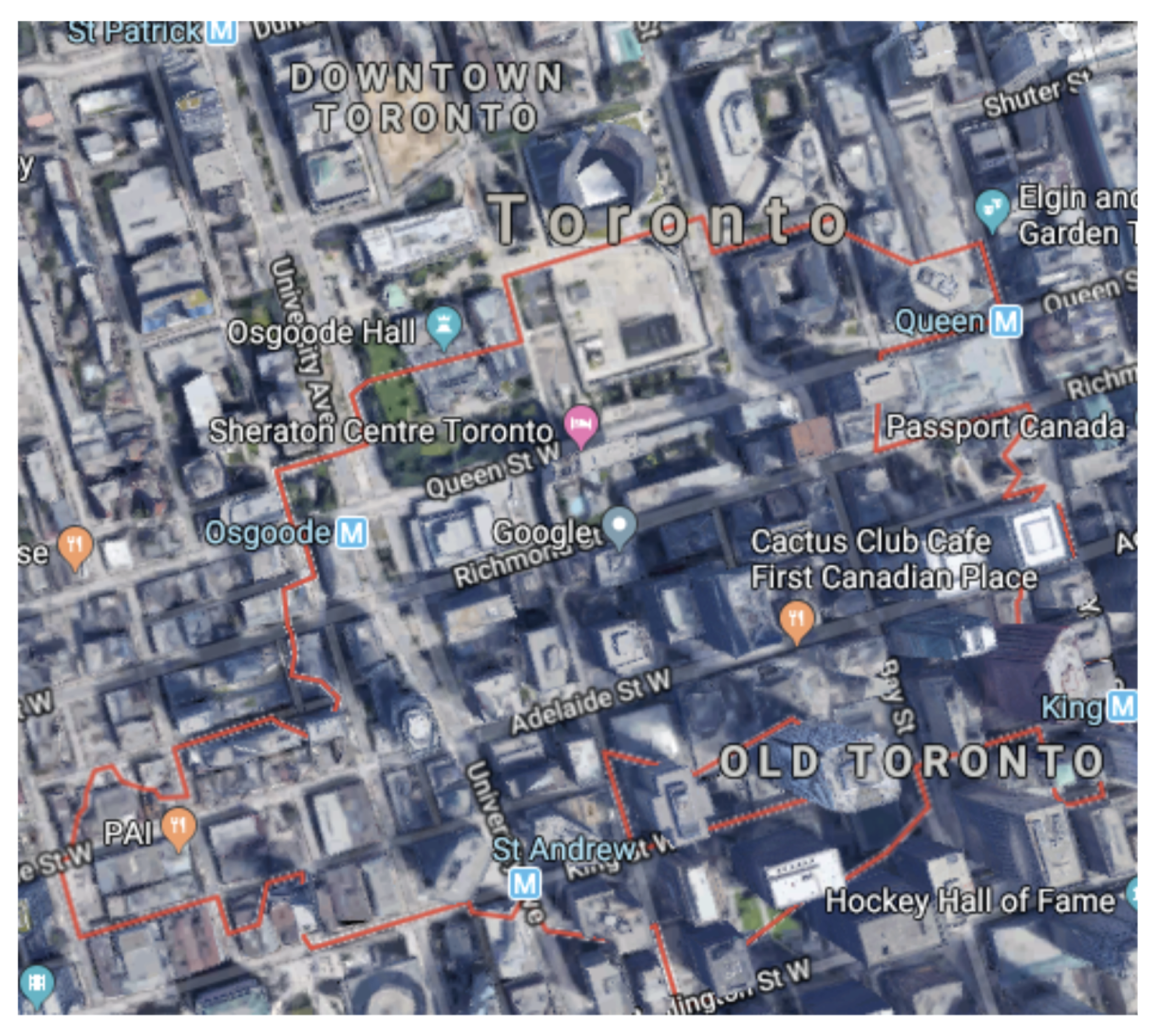If you love Toronto but want to save a buck or two on rent, stay clear of these 13 iconic landmarks and prominent buildings.
Rent in Toronto is unquestionably high. And depending on the neighbourhood, it can be even higher, making cheap rent in Toronto hard to find For instance, Torontonians choosing to live downtown will pay anywhere from $1,700 on the low-end, to $1,930 on the high-end per month just for a bachelor-suite. The price climbs for a one-bedroom apartment and climbs even higher for a two-bedroom.

Figure 1: Average Condo Lease Price in Downtown Toronto Neighbourhoods according to Roomvu
The M5H Neighbourhood:
1. The Sheraton Center Hotel
2. The Hilton Hotel
3. Google’s headquarters
5. Amazon’s head office

Figure 2: The M5H Neighbourhood
The M5H postal code, where Adelaide Street West, King Street West, Queen Street West, and Richmond Street West converge with York Street, Bay Street and University Avenue, is the most expensive postal code in the Greater Toronto Area for rental apartments.
A big part of factor explaining the high rent is the iconic hotels like the Sheraton Centre Hotel and the Hilton, along with the big-name company-headquarters like Google and Amazon located in this area.
Commonly known as Old Toronto, the average rent for a two-bedroom apartment in this area is almost $4,800 and $2,750 for a one-bedroom apartment per month (no cheap rent here).
The M4W Neighbourhood (Canada’s most highly-priced neighbourhood)
5. Rosedale
6. Governor’s Bridge

Figure 3: The M4W Neighbourhood
The M4W neighbourhood has an almost suburban feel, replete with cul-de-sacs and large estates, quite different than the previous M5H neighbourhood. But what makes this neighbourhood costly, isn’t a specific landmark but rather two names “Rosedale” and “Governors Bridge.”
According to many, just by saying you live in the neighbourhood screams “I’ve made it,” in the world of the richest, where the average household income is five times higher than the Canadian and Ontarian average.
In this area, the average rent for a two-bedroom apartment is nearly $3,800 and $2,530 for a one-bedroom.
The M5S Neighbourhood:
7. The University of Toronto (sorry students…)

Figure 4: The M5S Neighbourhood
The neighbourhoods of University and Harbord make up the M5S Postal Code. As the name of the former neighbourhood implies, this where lies the University of Toronto St.George Campus.
Many students and professors call this area home, with architecture comprising mainly standard Toronto Bay and Gable homes, as well as some low-rise apartments. The average two-bedroom rental apartment costs around $3,538, while a one-bedroom place will cost $2,447 monthly.
The M5E Neighbourhood:
8. The Gardiner Express Way
9. The St. Lawernce Market
10. The Hockey Hall of Fame
11. Future home to Mircosoft headquarters in 2020.

Figure 5: The M5E Neighbourhood
Despite being immediate to the southeast of the most expensive postal code in Toronto, renters living in a two-bedroom place in the M5E area can expect to pay about $500 less per month than their cousins to the northwest.
With two-bedroom rent going for an average of $3,500 per month and one-bedroom rent going for an average of $2,500, the M5E neighborhood is not only in close proximity to the Gardiner Expressway, but it is also home to the historic St.Lawrence Market and Hockey Hall of Fame.
And in addition, Microsoft announced its new headquarters opening in 2020 will be at 81 Bay St, meaning that it might be best to simply visit this area instead of trying to afford rent, as once the headquarters open, rent will likely shoot up.
The M6G Neighbourhood:
12. Palmerston “Little Italy”
13. Koreatown

Figure 6: The M6G Neighbourhood
The last two landmarks to avoid on our list if you want to pay cheap rent is the M6G neighborhood, also known as the fifth most expensive postal code in Toronto.
Home to Palmerston “Little Italy” and Koreatown, the average cost of a rental apartment here is $2,600 for a one-bedroom apartment and $3,550 for a two-bedroom apartment per month.
Alike Rosedale and Governors Bridge, these neighborhood names make them iconic, as “Little Italy” is mostly known for its Italian restaurants, businesses and wide, cobble-stoned streets, which mimic Italy. Much like Koreatown is known for its Korean restaurants, businesses and culture which mimic parts of Korea.
